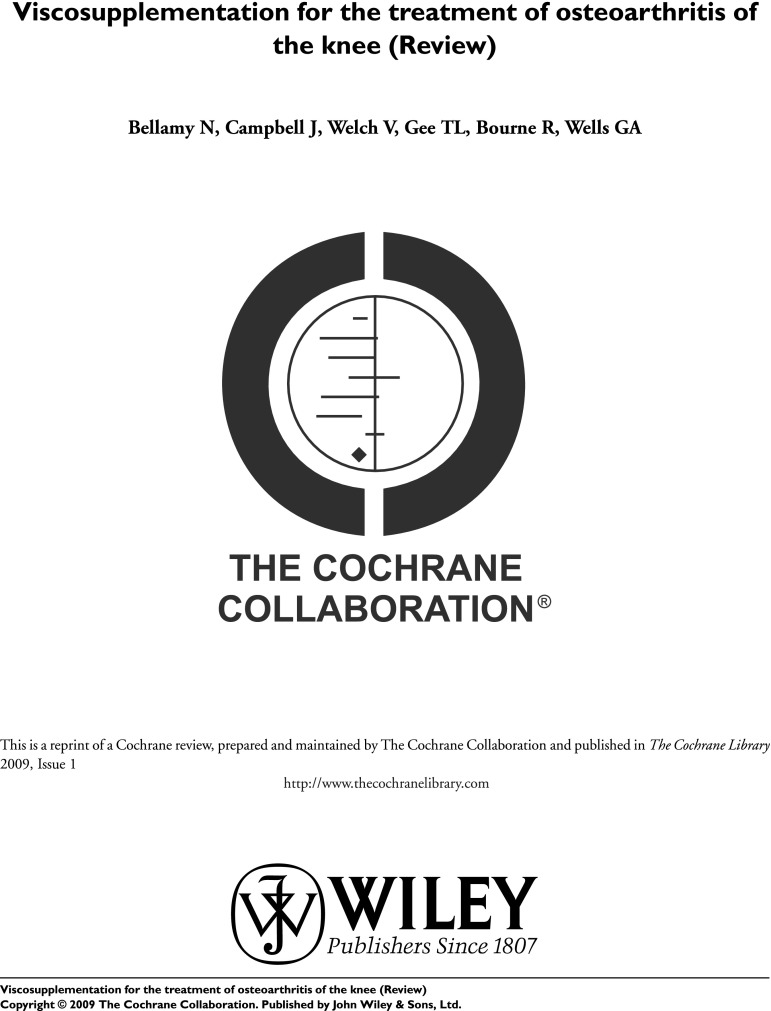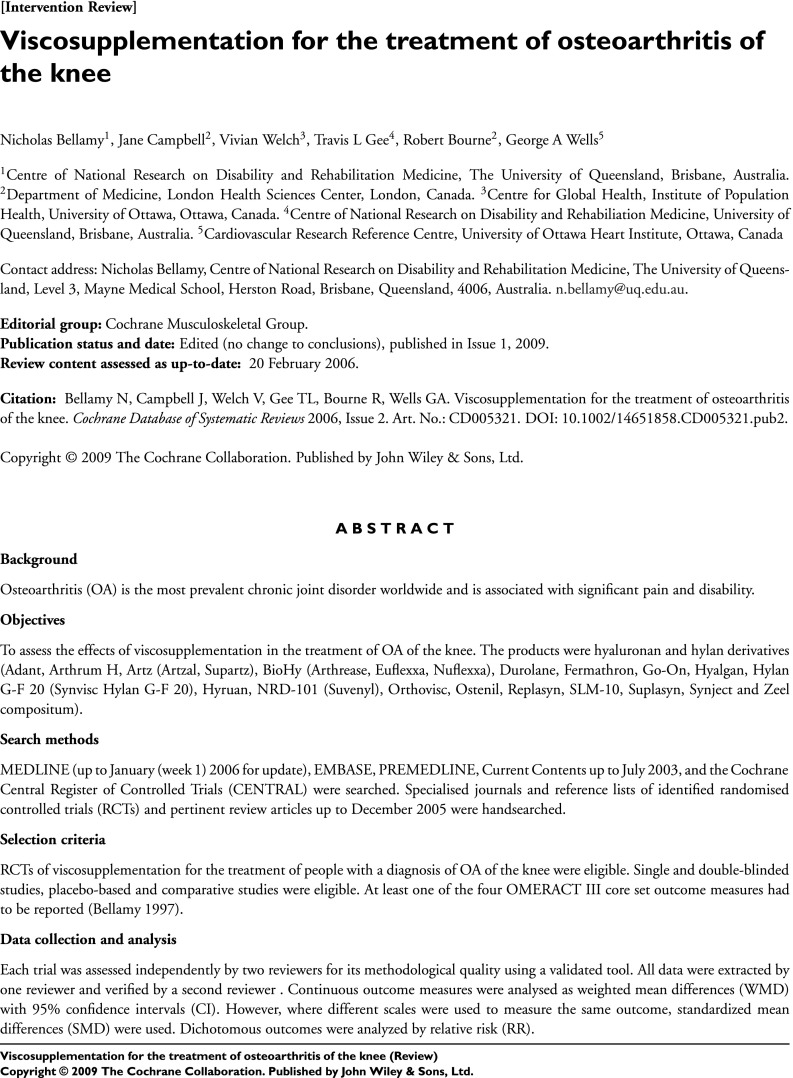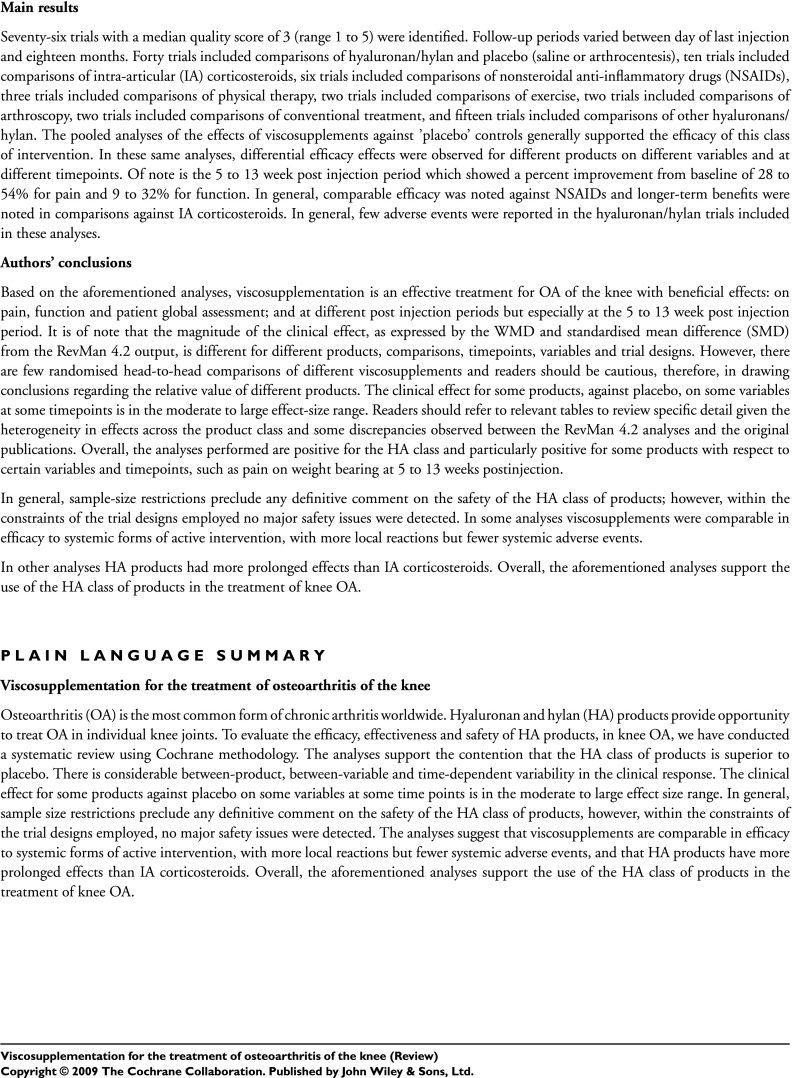Importance of the Topic
Osteoarthritis is the most common joint disorder in the world [1]. It affects approximately 15% of adults older than 45 years of age [19], and nearly half of all adults will experience symptomatic osteoarthritis by age 85 [20]. Osteoarthritis is more common than Type 2 diabetes and most forms of cancer [22, 24]. In the United States, osteoarthritis is second only to back pain as a cause of lost productivity [25], and annual total healthcare expenditures related to osteoarthritis are as high as USD 80 billion. This figure is expected to increase during the next decade [27]. The appropriate management of younger patients with mild or moderate osteoarthritis remains a challenging area in the day-by-day clinic and intense research is being conducted [5, 11, 15].
Hyaluronic acid is a glycosaminoglycan molecule made of repeating units of N-acetyl-glucosamine and glucoronic acid [3]. It is one of the main components of normal synovial fluid. Hyaluronic acid functions through antiinflammatory, anabolic, analagesic, and chondroprotective mechanisms [2]. Biomechanically, it may act as a viscoelastic shock absorber, and perhaps as a lubricant in the joint [6]. The synovial fluid in knees with osteoarthritis contains elevated levels of free radicals, inflammatory cytokines, and cleavage enzymes [13], which impair hyaluronic acid function and contribute to the progression of osteoarthritis [3]. Viscosupplementation attempts to restore the biomechanical and biochemical functions of normal synovial fluid through intraarticular injections of hyaluronic acid. This systematic review and meta-analysis examined the effects of viscosupplementation in the treatment of osteoarthritis of the knee.
Upon Closer Inspection
Several preparations of modern commercial hyaluronic acid are currently globally available. They differ mostly by molecular weight, method of production, half-lives, and cost [25]. They are produced either from harvested rooster combs or via bacterial fermentation in vitro [18]. Some can be administered in single-dose regimens, but most require three to five weekly injections [25]. Higher molecular weight hyaluronic acid is suggested to have greater clinical efficacy, but the current literature is inconclusive [17]. This meta-analysis included only randomized controlled trials, and compared 19 different formulations of hyaluronic acid across 76 studies (9847 patients). However, there were few head-to-head trials and firm conclusions about the relative value of each formulation were not possible. Additionally, a diversity of control interventions were utilized, including placebo, intraarticular corticosteroids, nonsteroidal antiinflammatory drugs, physiotherapy, and arthroscopy, which meant that most analyses were based on only a few small trials.
The authors reported no major safety issues for viscosupplementation, but cautioned that the included trials were underpowered to detect rare adverse events [4]. Self-limited (and benign) soft-tissue reactions at viscosupplementation injection sites have been reported in up to 3% of injections [25, 26], and several reports have also described a rare but much more severe acute local reaction known as “pseudosepsis.” Severe acute local reactions typically require arthrocentesis, nonsteroidal antiinflammatories, and intra-articular corticosteroid injections [12]. One study [16] reported a 21% incidence of severe acute local reactions in patients receiving more than one course of treatment, suggesting that patients who desire additional courses should be counseled of their possible increased risk. Future studies should investigate if certain patients are at risk for these reactions, and whether they could safely receive specific formulations [25]. Long-term safety could best be observed in large observational studies modeled after current total joint arthroplasty device registries or pharmaceutical postmarketing “phase-IV” surveillance studies [10, 14, 23].
Take-Home Messages
This Cochrane review found overall benefits to viscosupplementation in comparison to placebo for pain, function, and patient global assessment scores. Several other recent meta-analyses have produced conflicting results [9, 20, 28]. Rutjes et al. [21] found overall no clinically important benefit for pain intensity or frequency of osteoarthritis flares in 89 trials involving 12,667 patients, but high-molecular-weight and cross-linked preparations had greater effects, according to the Rutjes and colleagues study. Campbell et al. [9] reviewed six meta-analyses, and highlighted differences in search strategies, selection criteria, choices of pooled outcome measures and time-points, assessments of study quality, and selection of statistical model. Current clinical guidelines mention poor study quality, publication bias, conflicting results, industry-sponsorship, and unclear clinical significance for their inconclusive recommendations [7, 11, 29].
Based on the Grades of Recommendation Assessment, Development and Evaluation (GRADE) approach [8], viscosupplementation for knee osteoarthritis provides a probable pain reduction and improvement of physical function with a low-risk of harm [4, 9, 29]. It is a viable option in younger patients with less severe disease, but further investigations are still required. Future studies should examine whether high molecular weight and cross-linked preparations have superior efficacy, determine long-term outcomes and safety, and include economic analyses [4, 25]. Recurrent methodological limitations related to study heterogeneity, outcome reporting, and bias must be overcome [9, 11, 20, 29].
Appendix
Footnotes
A Note from the Editor-in-Chief: I am pleased to announce the partnership between CORR® , The Cochrane Collaboration® , and McMaster University’s Evidence-Based Orthopaedics Group for a new column, called Cochrane in CORR®. In the column, we will identify an abstract originally published in The Cochrane Library that we think is especially important, and colleagues from McMaster University will provide expert perspective on it.
(Bellamy N, Campbell J, Welch V, Gee TL, Bourne R, Wells GA. Viscosupplementation for the treatment of osteoarthritis of the knee. Cochrane Database of Systematic Reviews 2006, Issue 2. Art. No.: CD005321. DOI: 10.1002/14651858.CD005321.pub2.)
Copyright © 2009 The Cochrane Collaboration. Published by John Wiley & Sons, Ltd. Reproduced with permission.
The authors certify that they, or any members of their immediate family, have no funding or commercial associations (eg, consultancies, stock ownership, equity interest, patent/licensing arrangements, etc) that might pose a conflict of interest in connection with the submitted article.
All ICMJE Conflict of Interest Forms for authors and Clinical Orthopaedics and Related Research ® editors and board members are on file with the publication and can be viewed on request.
The opinions expressed are those of the writers, and do not reflect the opinion or policy of CORR ® or the Association of Bone and Joint Surgeons®.
Cochrane Reviews are regularly updated as new evidence emerges and in response to feedback, and The Cochrane Library (http://www.thecochranelibrary.com) should be consulted for the most recent version of the review.
References
- 1.Arden N, Nevitt MC. Osteoarthritis: Epidemiology. Best Pract Res Clin Rheumatol. 2006;20:3–25. doi: 10.1016/j.berh.2005.09.007. [DOI] [PubMed] [Google Scholar]
- 2.Axe JM, Snyder-Mackler L, Axe MJ. The role of viscosupplementation. Sports Med Arthrosc. 2013;21:18–22. doi: 10.1097/JSA.0b013e3182673241. [DOI] [PubMed] [Google Scholar]
- 3.Balazs EA, Denlinger JL. Viscosupplementation: A new concept in the treatment of osteoarthritis. J Rheumatol Suppl. 1993;39:3–9. [PubMed] [Google Scholar]
- 4.Bellamy N, Campbell J, Robinson V, Gee T, Bourne R, Wells G. Viscosupplementation for the treatment of osteoarthritis of the knee. Cochrane Database Syst Rev. 2006;(2):CD005321. [DOI] [PMC free article] [PubMed]
- 5.Bhandari M, Smith J, Miller LE, Block JE. Clinical and economic burden of revision knee arthroplasty. Clin Med Insights Arthritis Musculoskelet Disord. 2012;5:89–94. doi: 10.4137/CMAMD.S10859. [DOI] [PMC free article] [PubMed] [Google Scholar]
- 6.Brockmeier SF, Shaffer BS. Viscosupplementation therapy for osteoarthritis. Sports Med Arthrosc. 2006;14:155–162. doi: 10.1097/00132585-200609000-00007. [DOI] [PubMed] [Google Scholar]
- 7.Brown GA. AAOS clinical practice guideline: Treatment of osteoarthritis of the knee: Evidence based guideline, 2nd edition. J Am Acad Orthop Surg. 2013;21:577–579. doi: 10.5435/JAAOS-21-09-577. [DOI] [PubMed] [Google Scholar]
- 8.Brozek JL, Akl EA, Alonso-Coello P, Lang D, Jaeschke R, Williams JW, Phillips B, Lelgemann M, Lethaby A, Bousquet J, Guyatt GH, Schunneman HJ, GRADE Working Group Grading quality of evidence and strength of recommendations in clinical practice guidelines. part 1 of 3. an overview of the GRADE approach and grading quality of evidence about interventions. Allergy. 2009;64:669–677. doi: 10.1111/j.1398-9995.2009.01973.x. [DOI] [PubMed] [Google Scholar]
- 9.Campbell J, Bellamy N, Gee T. Differences between systematic reviews/meta-analyses of hyaluronic acid/hyaluronan/hylan in osteoarthritis of the knee. Osteoarthritis Cartilage. 2007;15:1424–1436. doi: 10.1016/j.joca.2007.01.022. [DOI] [PubMed] [Google Scholar]
- 10.Campbell M, Fitzpatrick R, Haines A, Kinmonth AL, Sandercock P, Spiegelhalter D, Tyrer P. Framework for design and evaluation of complex interventions to improve health. BMJ. 2000;321(7262):694–696. doi: 10.1136/bmj.321.7262.694. [DOI] [PMC free article] [PubMed] [Google Scholar]
- 11.Feeley BT, Gallo RA, Sherman S, Williams RJ. Management of osteoarthritis of the knee in the active patient. J Am Acad Orthop Surg. 2010;18:406–411. doi: 10.5435/00124635-201007000-00003. [DOI] [PubMed] [Google Scholar]
- 12.Goldberg VM, Coutts RD. Pseudoseptic reactions to hylan viscosupplementation: Diagnosis and treatment. Clin Orthop Relat Res. 2004;4(19):130–137. doi: 10.1097/00003086-200402000-00021. [DOI] [PubMed] [Google Scholar]
- 13.Greenwald RA. Oxygen radicals, inflammation, and arthritis: Pathophysiological considerations and implications for treatment. Semin Arthritis Rheum. 1991;20:219–240. doi: 10.1016/0049-0172(91)90018-U. [DOI] [PubMed] [Google Scholar]
- 14.Hoppe DJ, Schemitsch EH, Morshed S, Tornetta P,3rd, Bhandari M. Hierarchy of evidence: Where observational studies fit in and why we need them. J Bone Joint Surg Am. 2009;91;Suppl 3:2–9. [DOI] [PubMed]
- 15.Keeney JA, Eunice S, Pashos G, Wright RW, Clohisy JC. What is the evidence for total knee arthroplasty in young patients? A systematic review of the literature. Clin Orthop Relat Res. 2011;469:574–583. doi: 10.1007/s11999-010-1536-9. [DOI] [PMC free article] [PubMed] [Google Scholar]
- 16.Leopold SS, Warme WJ, Pettis PD, Shott S. Increased frequency of acute local reaction to intra-articular hylan G-F 20 (Synvisc) in patients receiving more than one course of treatment. J Bone Joint Surg. 2002;84-A:1619–1623. [DOI] [PubMed]
- 17.Maneiro E, de Andres MC, Fernandez-Sueiro JL, Galdo F, Blanco FJ. The biological action of hyaluronan on human osteoartritic articular chondrocytes: The importance of molecular weight. Clin Exp Rheumatol. 2004;22:307–312. [PubMed] [Google Scholar]
- 18.McArthur BA, Dy CJ, Fabricant PD, Valle AG. Long term safety, efficacy, and patient acceptability of hyaluronic acid injection in patients with painful osteoarthritis of the knee. Patient Prefer Adherence. 2012;6:905–910. doi: 10.2147/PPA.S27783. [DOI] [PMC free article] [PubMed] [Google Scholar]
- 19.Mody GM, Brooks PM. Improving musculoskeletal health: Global issues. Best Pract Res Clin Rheumatol. 2012;26:237–249. doi: 10.1016/j.berh.2012.03.002. [DOI] [PubMed] [Google Scholar]
- 20.Murphy L, Schwartz TA, Helmick CG, Renner JB, Tudor G, Koch G, Dragomir A, Kalsbeek WD, Luta G, Jordan JM. Lifetime risk of symptomatic knee osteoarthritis. Arthritis Rheum. 2008;59:1207–1213. doi: 10.1002/art.24021. [DOI] [PMC free article] [PubMed] [Google Scholar]
- 21.Rutjes AW, Juni P, da Costa BR, Trelle S, Nuesch E, Reichenbach S. Viscosupplementation for osteoarthritis of the knee: A systematic review and meta-analysis. Ann Intern Med. 2012;157:180–191. doi: 10.7326/0003-4819-157-3-201208070-00473. [DOI] [PubMed] [Google Scholar]
- 22.Sasieni PD, Shelton J, Ormiston-Smith N, Thomson CS, Silcocks PB. What is the lifetime risk of developing cancer? The effect of adjusting for multiple primaries. Br J Cancer. 2011;105:460–465. doi: 10.1038/bjc.2011.250. [DOI] [PMC free article] [PubMed] [Google Scholar]
- 23.Sedrakyan A, Paxton EW, Phillips C, Namba R, Funahashi T, Barber T, Sculco T, Padgett D, Wright T, Marinac-Dabic D. The International Consortium of Orthopaedic Registries: overview and summary. J Bone Joint Surg Am. 2011;93(Suppl 3):1–12. doi: 10.2106/JBJS.K.01125. [DOI] [PubMed] [Google Scholar]
- 24.Shaw JE, Sicree RA, Zimmet PZ. Global estimates of the prevalence of diabetes for 2010 and 2030. Diabetes Res Clin Pract. 2010;87:4–14. doi: 10.1016/j.diabres.2009.10.007. [DOI] [PubMed] [Google Scholar]
- 25.Strauss EJ, Hart JA, Miller MD, Altman RD, Rosen JE. Hyaluronic acid viscosupplementation and osteoarthritis: Current uses and future directions. Am J Sports Med. 2009;37:1636–1644. doi: 10.1177/0363546508326984. [DOI] [PubMed] [Google Scholar]
- 26.Waddell DD. Viscosupplementation with hyaluronans for osteoarthritis of the knee: Clinical efficacy and economic implications. Drugs Aging. 2007;24:629–642. doi: 10.2165/00002512-200724080-00002. [DOI] [PubMed] [Google Scholar]
- 27.Yelin E, Murphy L, Cisternas MG, Foreman AJ, Pasta DJ, Helmick CG. Medical care expenditures and earnings losses among persons with arthritis and other rheumatic conditions in 2003, and comparisons with 1997. Arthritis Rheum. 2007;56:1397. doi: 10.1002/art.22565. [DOI] [PMC free article] [PubMed] [Google Scholar]
- 28.Zhang W, Moskowitz RW, Nuki G, Abramson S, Altman RD, Arden N, Bierma-Zeinstra S, Brandt KD, Croft P, Doherty M, Dougados M, Hochberg M, Hunter DJ, Kwoh K, Lomander LS, Tugwell P. OARSI recommendations for the management of hip and knee osteoarthritis, part I: Critical appraisal of existing treatment guidelines and systematic review of current research evidence. Osteoarthritis Cartilage. 2007;15:981–1000. doi: 10.1016/j.joca.2007.06.014. [DOI] [PubMed] [Google Scholar]
- 29.Zhang W, Moskowitz RW, Nuki G, Abramson S, Altman RD, Arden N, Bierma-Zeinstra S, Brandt KD, Croft P, Doherty M, Dougados M, Hochberg M, Hunter DJ, Kwoh K, Lomander LS, Tugwell P. OARSI recommendations for the management of hip and knee osteoarthritis: Part III: Changes in evidence following systematic cumulative update of research published through January 2009. Osteoarthritis Cartilage. 2010;18:476–499. doi: 10.1016/j.joca.2010.01.013. [DOI] [PubMed] [Google Scholar]





